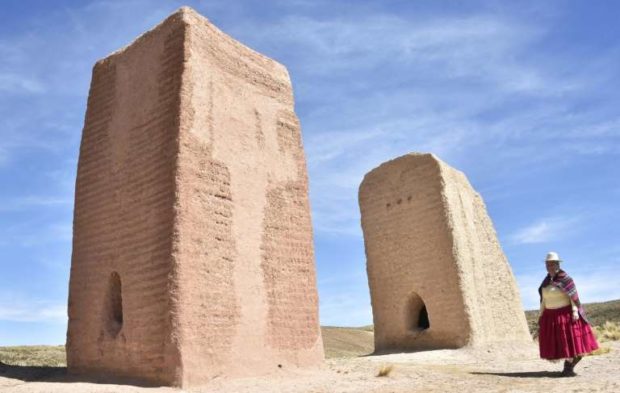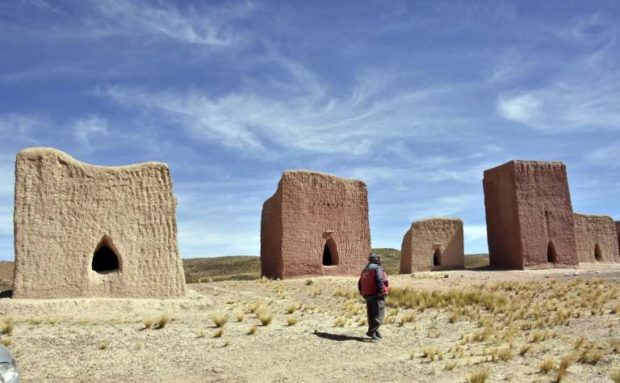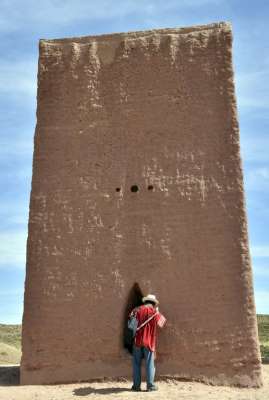Bolivia restores myth-generating funerary towers

All the small doorways in the chullpas funerary towers face east, a fact that has been responsible for the development of numerous myths and legends. Image: AFP/Aizar Raldes
Unique quadrangular pre-Inca towers made of earth and straw, standing up to eight meters tall, dot the landscape at Condor Amaya on the Bolivian altiplano, giving rise to myths and legends.
These eight “chullpas” standing almost side by side are funerary towers that have been built with a technique unique to this site in the Bolivian Andes.
Severina Flores, a skilled wool weaver and sheep breeder, remembered that she was scared of the towers when she was young.
“Before, when I was ‘wawa’ (a child) we would never approach them because when we did we would fall ill,” the 29-year-old mother of four told AFP.
The chullpas measure between two and eight meters high and two to four meters wide. They all have a small entrance door facing the rising sun in the east.

The chullpas funerary towers are made mostly from straw and mud, with some stone and a secret organic material yet to be identifed. Image: AFP/Aizar Raldes
That gave rise to myths and legends relating to the sun.
A story told by a Don Estanislao Colque claims that the pre-Incan towers “lived with the moon” and “walked on the earth” many generations ago.
But the earth changed position and the sun stopped rising in the west to be born again sometime later in the east, “burning” all those chullpas facing the other way.

Some local people used to be afraid of the towers, believing them to cause illnesses. Image: AFP/Aizar Raldes
“It’s a myth, but valuable because mythology is also part of a heritage,” Greek archeologist Irene Delaveris said.
Other, more rational, explanations for the doors’ orientation include wind and rain arriving from the west.
The towers were built during two cultural periods, the pre-Incan Aymara kingdoms and the Inca-Pacajes period, conservation expert Guido Mamani told AFP.
“The oldest of these towers were built in the 15th century,” Delaveris stated.
Chullpas were first built in the 10th and 11th centuries by the Aymara kingdoms following the end of the Tiwanaku culture. The practice continued through the Inca period until the arrival of Spanish conquistadors.

Experts say these funerary towers are unique for the way in which they were built. Image: AFP/Aizar Raldes
They were used for the burials of royalty, military officials or wealthy people.
Condor Amaya, known as Kuntur Amaya in the Aymara language, is a small village of 40 families around 130 kilometers (80 miles) to the southwest of La Paz.
It has 11 funerary towers restored by the culture ministry in collaboration with the government of Switzerland.
There are 39 chullpas in the area, some in ruins, ravaged by time and the unforgiving climate. In the La Paz department, there is around 300 overall, according to the culture ministry.
There are also similar funerary structures in neighboring Peru, but those are circular.
“For me, it’s an expression of engineering that is unique in the world, because these constructions were not built in any other part of the world with this technique,” Delaveris said.
“The walls appear to be made from ‘a mix of whole straw with mud’ which generates a material like fabric,” she added.
However, there is a secret organic ingredient as well, yet to be identified, that “could be the collagen in llama bones or a local plant that gave it that hardness that has allowed it to be preserved over centuries.” HM/JB
RELATED STORIES:
Masters of puppets: Indonesia’s ‘Ondel-Ondel’ kids